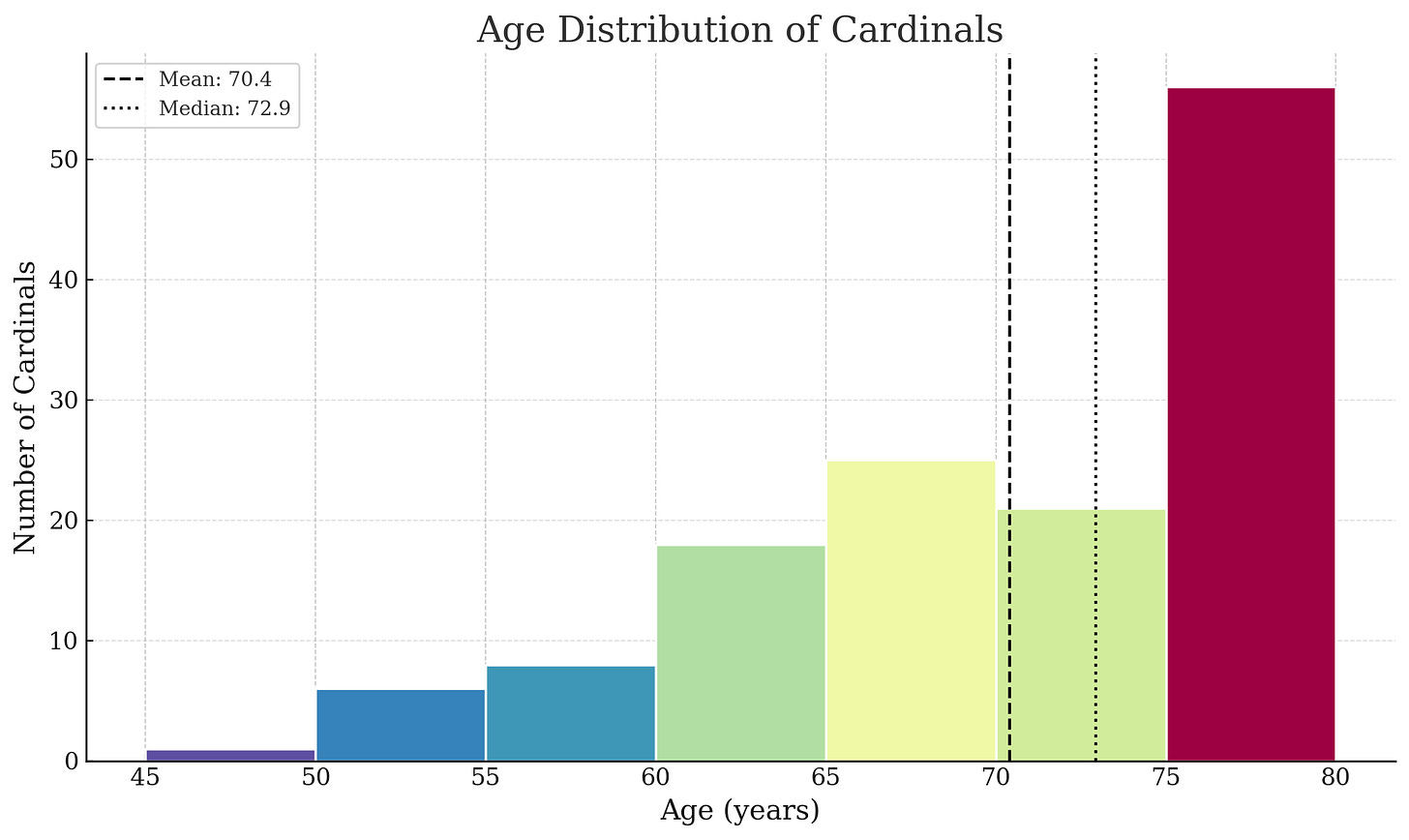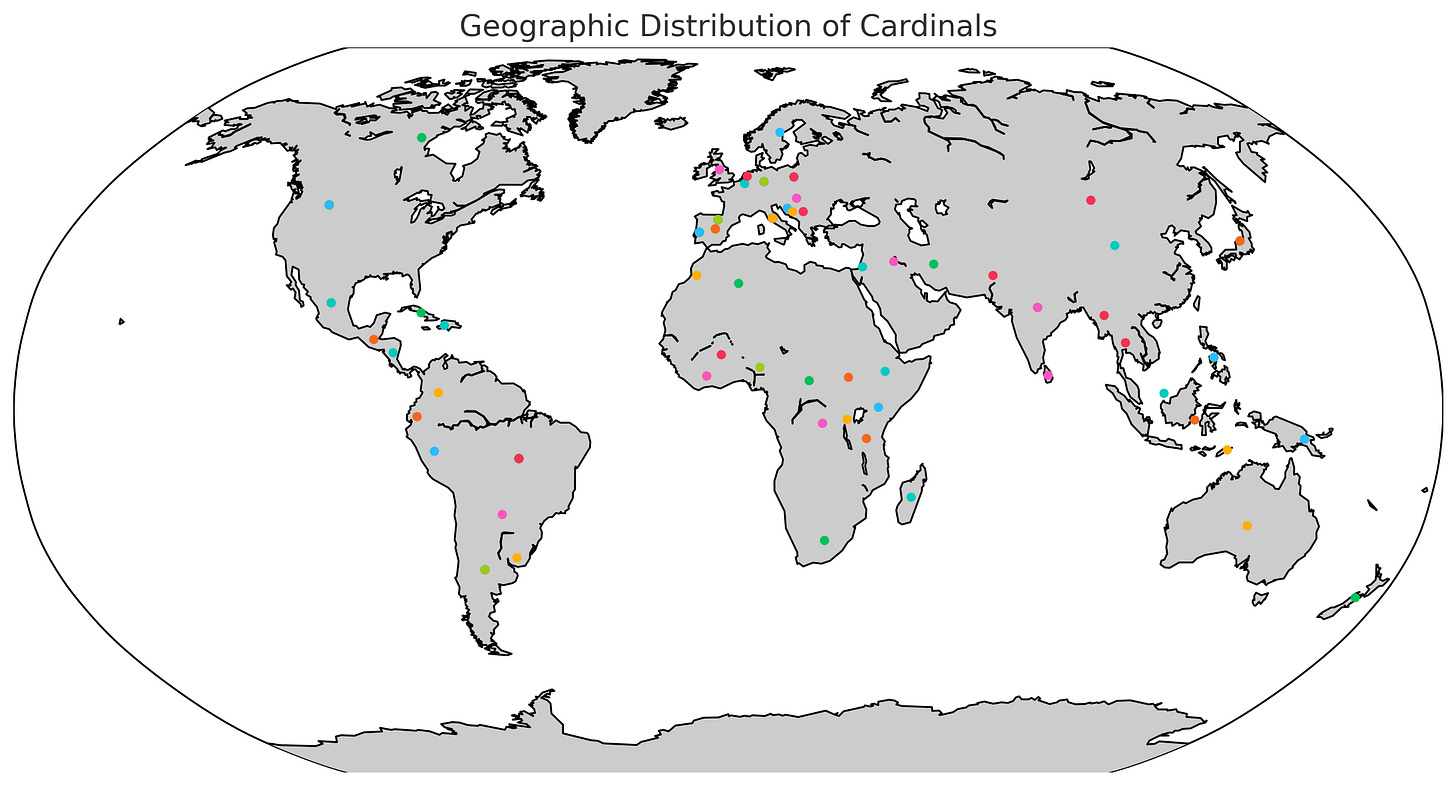Inside the Conclave: who will the next pope be?
As speculation of what will happen inside the Sistine Chapel increases, I present data from betting markets, google trends, age and geography. Here is what the numbers say who might be the next pope!
After the death of Pope Francis on Monday morning (21 April), the norms of the Catholic Church dictate that a new pope is elected by cardinals - in a gathering called a ‘Conclave’ (Latin for ‘a room that can be locked up”) which is usually held 15-20 days after the pope’s death. Cardinals must be under 80 years old to cast a vote for a new pope. Four rounds of balloting happen daily until a candidate receives two-thirds of the vote. In theory, any baptised Catholic man can become the pope. In practice, however, only cardinals have been elected as popes since at least the 14th century.
Cardinal’s data
Let’s look at those cardinals that can vote. First, of the 252 members, 135 are currently eligible to vote for the pope (of which likely 133 will be present), as they meet the age requirement of being younger than 80 years old. With a mean age of 70.4 and a median of 72.9, we can conclude that the young cardinals are not very present to say the least.
What about geographically? Pope Francis broke some barriers by being the first Latin American pope, is this likely to happen again?
No surprises here. Italy and Europe are still very strong in the majority (Europe ≈ 54 %, Asia ≈ 14 %, Africa ≈ 14 %, Americas ≈ 17 %, Oceania ≈ 1 %).
Betting markets
Let’s do something rather un-Catholic. Let’s look at the betting markets. Demography is destiny - yet bettors look elsewhere for signals. The main betting market is Polymarket, a blockchain-based prediction market. The "Who will be the next Pope?" market has seen a modest $4 million in total volume. (In comparison: the outcome of the Canadian election, by contrast, has seen more than $55 million in bets.). Nevertheless, there is a clear winner.
The 70-year-old Italian cardinal, Pietro Parolin, is the favored successor to Pope Francis, with a 29% chance of being selected - the blue line is gliding steadily at the moment. He currently holds the number two position in the Vatican: Secretary of State (since 2013). Though he was supportive of much of Pope Francis’s agenda, Parolin is seen as more of a moderate figure.
After Parolin, the next most likely to be elected is Luis Antonio Tagle, a 67-year-old Filipino cardinal who has previously been called the “Asian Francis” due to his alignment to the pontificate’s values and agenda. Polymarket currently has him favored at 22%.
For those interested, the graph also shows some other key events. For instance, the Zuppi-mania: when Cardinal matteo Zuppi finished a pastoral tour of Bologna with a widely streamed Mass and Italian press started talking about “grass-roots charisma” which rocketed up market bets. Then there are 3 Pizzaballa events leading to market volatility too: after Cardinal Pierbattista Pizzaballa’s visit to Bahrain, bettors briefly crowned him the favorite. Eight hours later, when U.S. retail wallets woke up, a second buying wave pushed Pizzaballa to a new intraday high of 47%. By early afternoon Vatican reporters reminded everyone that Pizzaballa has limited curial experience.
Do note that in the betting market there is low liquidity at the moment and that favorites sometimes lose (e.g., Bergoglio was 15th in 2013). Only 4 of the last 10 conclaves chose the betting favorite. Considering this, let’s see if the betting market aligns with the google trends data, often a decent proxy for predictions too.
Google trends data
Pietro Parolin seems to be winning there too. Thus, the markets and google searches have spoken and the geographic data does not seem to contradict.
Nevertheless, as anybody who saw the 2024 movie "Conclave" can attest, the outcome of such meetings is by design largely unpredictable. There are more than 130 cardinals, and the next pope could be any of them. Let’s wait and see!








